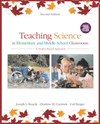 |  Teaching Children Science: A Project-Based Approach, 2/e Joe Krajcik,
University of Michigan - Ann Arbor
Charlene Czerniak,
University of Toledo
Carl Berger,
University of Michigan - Ann Arbor
How Do I Develop and Use Benchmark Lessons?
Chapter Summary- Benchmark lessons play a critical role in project-based science.
- Benchmark lessons
- Help students learn difficult concepts during project activities.
- Illustrate important laboratory techniques.
- Develop investigation strategies that students will need to complete a project.
- Model thinking.
- Stimulate curiosity.
- Teachers decide when to plan a benchmark lesson by
- Using concept maps to evaluate what students understand.
- Observing and listening to students.
- Using the KWL strategy to probe what students know, want to know, and have learned.
- Benchmark lessons must be carefully planned to be successful.
- Lesson plans are a roadmap to teaching.
- The learning cycle model and the 5-E model are constructivist models for planning lessons.
- Several tools enhance benchmark lessons:
- Demonstrations.
- Discrepant events.
- Student demonstrations.
- Large group discussions.
- Discussions must be planned to ensure success.
- Wait-time, probing, and redirecting are techniques that can be used to improve the quality of discussions.
- Sometimes information must be presented to students.
- Several tools are useful in presenting information:
- Metaphors, similes, and analogies.
- Diagrams, graphs, and pictures.
- Movies, videos, and educational television.
- Guest lectures.
- Community resources.
- Reading is an important aspect of project-based science.
- Teachers use many reading resources in project-based science:
- Children's literature.
- Magazines and periodicals for children.
- The World Wide Web.
- Teachers must help students make sense of written material. This can be accomplished through questioning, monitoring of reading, and student evaluation of reading materials.
- Questioning is critical in project-based science.
- Different types of questions affect the quality of responses from students and classroom discourse.
|
|



 2003 McGraw-Hill Higher Education
2003 McGraw-Hill Higher Education